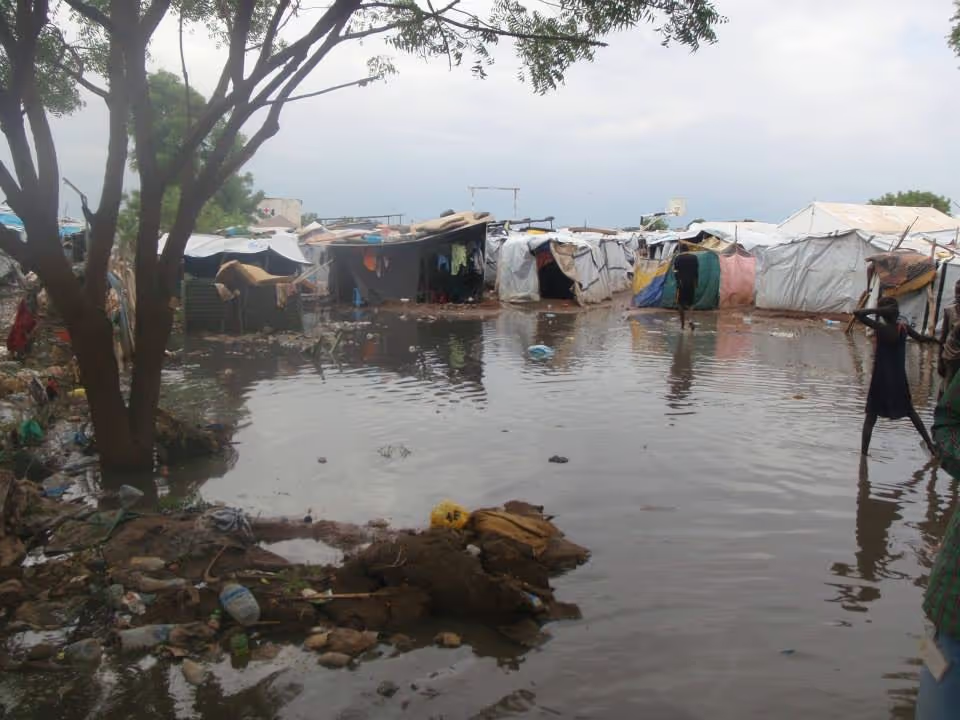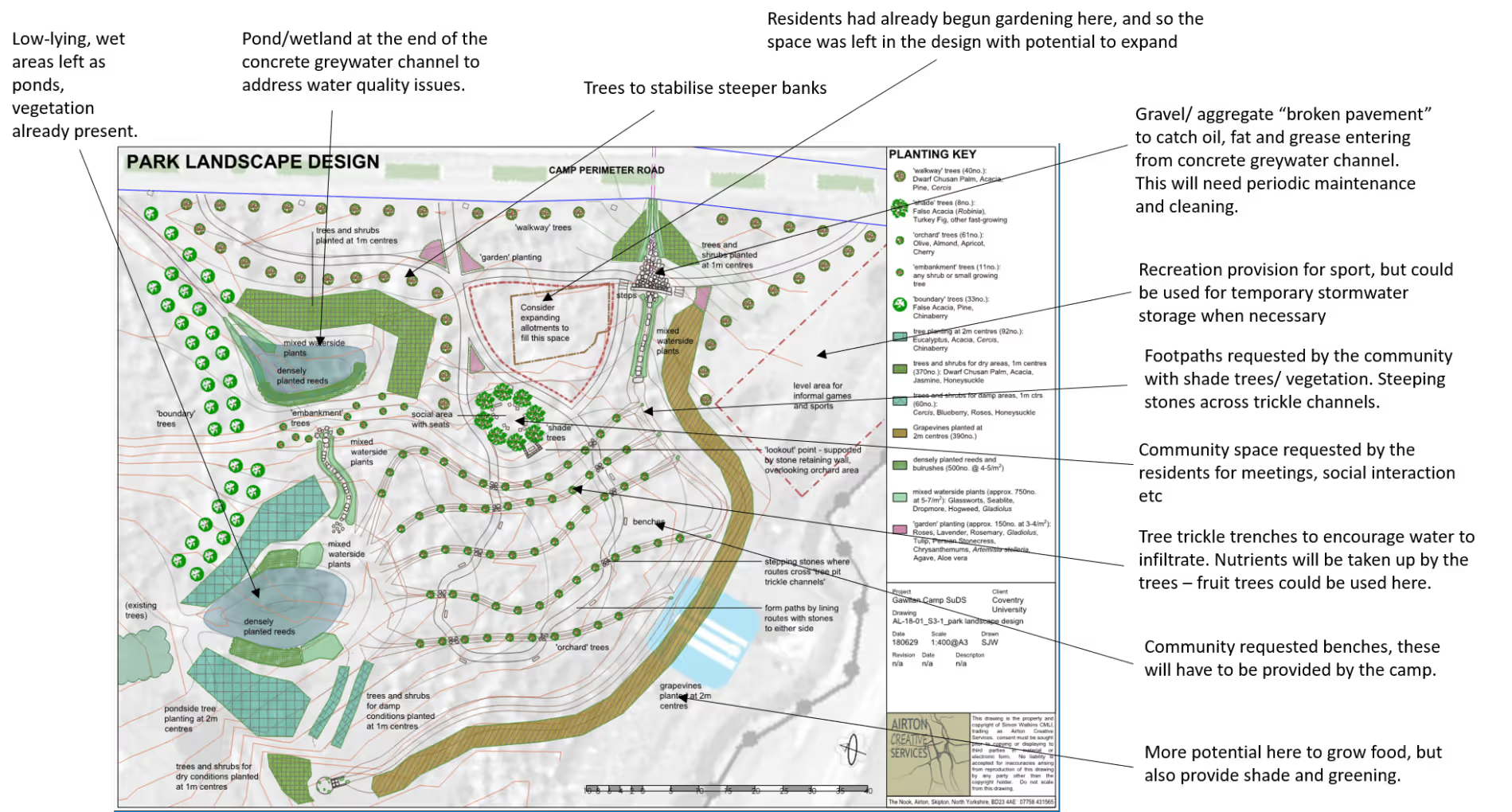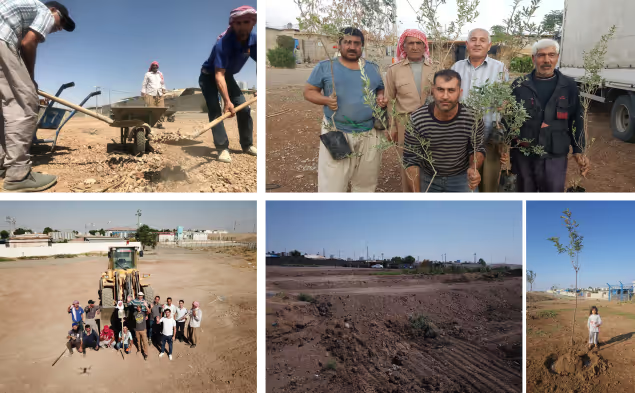Designing, constructing and monitoring a SuDS demonstration site at Gawilan refugee camp, Iraq

Project aims
Our project aims evolved from the fact that surface water drainage (of rainwater as well as greywater from personal washing, preparing vegetables, clothes washing etc) is generally not considered when a refugee camp is initially set up. As a result, polluted streams can flow through the camps, beyond the camp boundaries, and into the surrounding environment. This is not good for either human or environmental health. Very often large pipes, ditches and open concrete channels which are not fit for purpose are retrofitted, resulting in flooding and pools of standing water.
We therefore wanted to trial a Sustainable Drainage System (SuDS) management train with the ambition that water would be dealt with inside the camp boundary. This would conform to the SuDS Square whereby reducing water volume and flow, improving the quality of the water, providing space for amenity provision for residents and also for biodiversity, would assume equal importance in the design. The management train would deal with long term discharge of low volumes of greywater, and potentially large volumes of storm water in the short term.
At the outset, we acknowledged the importance of engaging with stakeholders and the refugee community in identifying a suitable site, and in designing the management train.
Outcomes
Other blogs about this project have discussed the physical information needed to design a SuDS management train, such as soil type, soil structure and characteristic, hydrology of the area, topography, water quality and distribution of wet areas. We also detailed how important it was to engage with the community in such a project, enabling them to design the site as they wished via workshops, site walkovers and discussions of drainage to establish the “lie of the land”. Interestingly, throughout all of these activities residents expressed that they wanted the camp layout to remind them of home, of Syria. The resident’s design was drawn up by a landscape architect and is shown in Figure 1 below, please click here to see the image in full. It indicates where the community requested a “community space” to hold meetings under the shade of trees, footpaths around the site, a space for children to play sport and, of course, the area protected where they garden, with the potential to expand this.

We were delighted that Arup contacted us to request that our site be included as an exemplar in their HIF-funded guidance: “Surface water management in humanitarian contexts”. The guidance includes information on how the site was designed, lessons that we learnt from the exercise and potential risks.
By November 2018, progress constructing the management train was progressing well, with trickle trenches dug, trees planted in pits and trenches, ponds excavated and grapevines planted. The site was constructed with the community, being based on the design that they produced during the engagement process, and employing them through a cash-for-work scheme to help with the construction. Some work was carried out by hand, but for the heavier landscaping work, a bulldozer and driver were hired.
The images in Figure 2 below show (clockwise, top right to bottom left): hand digging of tree pits, trees ready to be planted, watering the trees to ensure they established well, terracing complete, the team. The latter photograph was taken by the drone we bought from the project: permission to overfly the site was gained from local management of the camp.

As you can see from the aerial view in Figure 3, at the beginning of November 2018, the site was looking good. One of the greywater ponds had some water in it, but the others connected to the trickle trenches were empty. The trickle trenches were also empty, with the trees planted in these watered to ensure that they survived.

The community had already started gardening on the site, so we left that area alone to encourage them to continue. Figure 4 shows a member of the community engaged in gardening activities.
Unfortunately, work had to stop at the end of November 2018 when an unprecedented one in 200 year storm hit the region, forcing 250,000 people out of their homes, including those in refugee and IDP camps, and sadly killing 28. A state of emergency was called on December 3 2018.
However, as the two photos in Figure 5 show, the site, even though not fully landscaped, behaved in the way that we hoped it would: water was distributed around the site in the trickle trenches, the ponds filled to store the water and then dissipated it slowly, and the wet areas managed the water by also storing and slowly dissipating it. We are therefore hopeful that once the site is completely finished, it will perform even better in the long term.
Next Steps
We are now concentrating on finally finishing the site. Following an initial assessment of damage, all of the trees have survived, and any damage to the landscaping has been easily rectified. The rainy season has extended through March, which, whilst not necessarily unusual, has led to muddy conditions which have stopped the use of the bulldozer. However, we now have all the required materials on site and are ready to continue once the site has dried out sufficiently.
In the long term, we intend to monitor the site around the SuDS square as is shown in the Figure 6 flowchart. We will engage a local company to undertake water quality analysis to compare these results with those before the site was built. We also wish to monitor the way in which the site manages storm and greywater bearing in mind our ambition that none will leave the boundary fence. This will be carried out by the community through Participatory Action Research (PAR), in that they will report to us regularly on water behaviour. PAR will also enable the monitoring of site amenity usage, such as use of the footpaths, community area, sports pitch and gardening. Biodiversity will also be monitored in this way. We hope to be able to carry this out over the next two years, and will extend beyond this if funding allows.
Funding
We were successful in an internal Coventry University funding call to generate and collect impact. This will allow us to hold two workshops for NGOs, local management, WASH engineers and other stakeholders to show them our demonstration site. We will also be putting together some teaching materials to show how to design, construct, maintain, and operate the SuDS devices. We have some short videos which we will be editing to supplement the teaching materials, and will be sharing with Elrha who have offered to host these on their website. In the long term we are seeking funding for retrofit at the camp scale, and to investigate the potential of Natural Flood Resilience Management at the catchment/ sub-catchment scale.
Cover Photo by V. Hammond
Stay updated
Sign up for our newsletter to receive regular updates on resources, news, and insights like this. Don’t miss out on important information that can help you stay informed and engaged.
Related articles
.png)


Explore Elrha
Learn more about our mission, the organisations we support, and the resources we provide to drive research and innovation in humanitarian response.